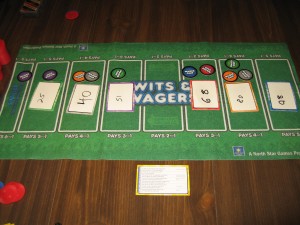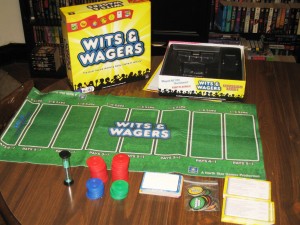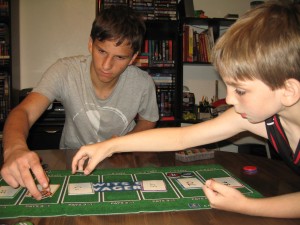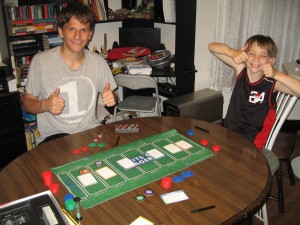I recently reviewed Wits & Wagers Family and promised a separate review of this edition, mainly because the components and bidding mechanics were slightly different. Both have the same general premise but as you’ll soon see, this version is a bit more complicated.
Editor’s Note: There are seven markerboards, so you can play up to seven players without needing teams. Players are free to pair off however they wish.
In Wits & Wagers, players will be trying to earn the most points by answering trivia questions and bidding on the best answer. Let’s take a moment to look at the components and gameplay before heading into the review.
Components
Game Mat – The game mat helps to organize answers and serves as a guide for when placing and paying out on bets.
Markerboards and Markers – Each player receives one of each and uses them to write down and submit their answers to the trivia questions.
Wager Chips & Plastic Chips – Each player receives two cardboard wager chips, which are used during bidding. The plastic “poker chips” can be added to the wager chips to increase the bet’s value, at the risk of losing that extra bet. Wager chips and red chips are worth one point, blue chips are worth five points, and green chips are worth twenty-five.
Sand Timer – The sand timer is used during bidding and when answering questions to keep the game moving.
Trivia Questions – Players will be answering these in an effort to score points. All answers will be in a numeric form, so players need only to write a number on their markerboard when answering questions.
Setup & Gameplay
Each player receives a marker, markerboard, and two wager chips of their color. The game mat is laid out in the center of the table. Players pick someone to be the banker and/or trivia question reader, and the plastic chips are placed within reach of the banker.
A round begins with the reading of a trivia question. The sand timer is flipped and players answer the question on their respective markerboards. When they are all done, they place their markerboards into the center of the table, arranging them on the mat from the lowest numeric answer to the highest numeric answer. If an odd number of answers result, the center slot is used on the mat (2 to 1). If an even number of answers result, the center slot is not used. This will change from round to round as players may pick the same answers.
Once the answers are arranged, the players place bets on them, choosing the ones that they think are the best answers. There is also a 6 to 1 slot that players may bet on if they feel that all of the answers on the table are greater than the actual answer. Each player has two wager chips, so they can bet on (and up to) two different answers. Each wager chip counts as one point, but players may add to that with the plastic chips. If they end up losing the bet however, they lose any extra chips they added to the bet. Players never lose their wager chips. Once again, the sand timer is used to help speed along play.

Players can spread out their bets to ensure they get something, or focus their bet in the hopes they make out like bandits.
Finally, once all bets are on the table, the answer is revealed. The winning answer is the one on the table closest to the actual answer without going over. Everyone else loses their bet. The winners receive their bet multiplied by the odds listed. For example, if someone bet five chips (one wager chip and four red chips) on three to one odds and won, they’d receive fifteen chips in winnings plus get their original bet back.
The next trivia question is read and the process repeats. The game ends after seven questions have been read and the winner is the person with the most points (via their chips).
The Review
As you can see from the above, the play mechanics are slightly different from the family edition and may confuse younger kids. For this reason, I recommend Wits & Wagers for when you have parties…the more players you have playing, the better. Some of the questions are definitely geared towards adults, however, I did come across a few repeats…that is, questions that were asked in the family edition. “What percent of US households own at least one pet cat?” is an example of a question asked in both editions of the game.
The poker chips are a nice touch and I definitely enjoyed using those over meeples (the betting mechanic in the family edition). You have more options with the chips and are able to be as risky or as safe as you want to be. This opens the door for a wider range of scores and strategy.
While the game is listed as being four players minimum, three is possible (though not ideal) if you’re willing to be creative. For example, each player could receive two marker boards and two sets of wager chips, allowing them to guess twice and bet with four wager chips instead of two. Again, it’s not ideal, but it worked okay for when the boys and I were playing. The game was playable with an eleven year old, so as long as I picked and chose which questions I read. Both Anthony (16) and Vinnie Jr (11) enjoyed playing my variant, and having four betting chips and two answer boards gave them more options. They both felt that seven rounds weren’t enough, so we played to about twelve.
Overall, Wits & Wagers is a good addition to your “party game” collection. It can be played as a game on family game night with the right tweaks, and some families may even find it better than the family edition. Still, if you have very young kids and want to let them in on the fun, I’d recommend the family edition. Otherwise, this edition will work just as well, if not better.
Final Verdict: 8/10
—



